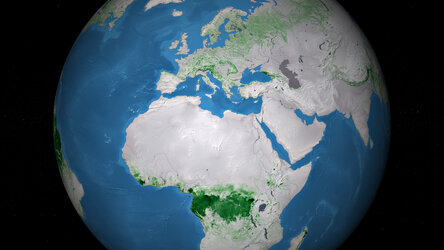Lichen survives in space
One of the main focuses in the search for living organisms on other planets and the possibilities for transfer of life between planets currently centres on bacteria, due to the organism's simplicity and the possibility of it surviving an interplanetary journey exposed to the harsh space environment.
This focus may develop to encompass more advanced organisms following the results of an ESA experiment on the recent Foton-M2 mission where it was discovered that lichens are very adept at surviving in open space.
Lichens are not actually single organisms but an association of millions of algal cells, which cooperate in the process of photosynthesis and are held in a fungal mesh. The algal cells and the fungus have a symbiotic relationship, with the algal cells providing the fungus with food and the fungus providing the alga with a suitable living environment for growth. Lichens are well known extremophiles, being able to survive the harshest environments on Earth. The most striking element of the finding is the complexity of this organism: it is multicellular, it is macroscopic and it is a eukaryote, meaning that on the evolutionary scale it is a much more modern organism than bacteria. In fact lichens can be considered as very simple ecosystems.
The experiment which took place during the Foton mission was called ‘Lichens’ and was one of the exobiology experiments that was located in the ESA Biopan facility. This exposure facility was located on the outer shell of the Foton return module and, once at the correct orbital altitude, opened to exposure the samples inside to open space, i.e. exposed to vacuum, wide fluctuations of temperature, the complete spectrum of solar UV light and bombarded with cosmic radiation. During the Foton-M2 mission, which was launched into low-Earth orbit on 31 May 2005, the lichens, which came from two different species (Rhizocarpon geographicum and Xanthoria elegans) were exposed for a total 14.6 days before being returned to Earth. At the conclusion of the mission the lid of Biopan was closed to protect the lichens from the conditions of reentry. The Biopan was thereafter transported back to ESA ‘s research facility, ESTEC, in Noordwijk, the Netherlands to be opened.

The results of the experiment were presented by one of the experiment team members, Dr. Rosa de la Torre from the Spanish Aerospace Research Establishment (INTA) in Madrid, at a post-flight review in October at ESTEC. Initial conclusions of the experiment, which is under the scientific leadership of Prof. Leopoldo Sancho from the Complutense University of Madrid, indicate that lichens have the capacity to resist full exposure to the harsh space conditions, especially high levels of UV radiation. Analysis post flight showed a full rate of survival and an unchanged ability for photosynthesis.
This experiment opens up many possibilities for future research into the possibility of transfer of life between planets. Follow up experiments could focus on questions such as to what extent lichen, if transported by a meteorite, can survive the reentry conditions into Earth’s atmosphere, i.e. what degree of shielding would be needed for lichen samples to survive? The outcome of this Biopan experiment also suggests that lichens might survive at the surface of Mars. Follow-up experiments on ground and in space are bound to provide further answers to these intriguing astrobiological questions.















 Germany
Germany
 Austria
Austria
 Belgium
Belgium
 Denmark
Denmark
 Spain
Spain
 Estonia
Estonia
 Finland
Finland
 France
France
 Greece
Greece
 Hungary
Hungary
 Ireland
Ireland
 Italy
Italy
 Luxembourg
Luxembourg
 Norway
Norway
 The Netherlands
The Netherlands
 Poland
Poland
 Portugal
Portugal
 Czechia
Czechia
 Romania
Romania
 United Kingdom
United Kingdom
 Slovenia
Slovenia
 Sweden
Sweden
 Switzerland
Switzerland




























